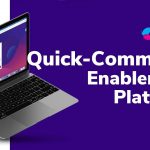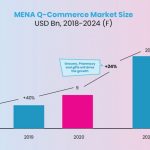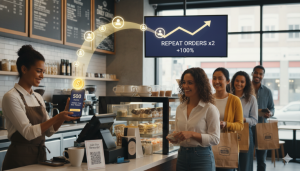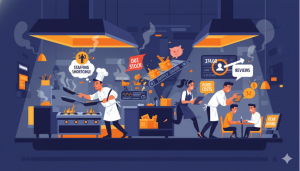With the growing internet economy, the importance of last-mile delivery continues to increase.
Quick Commerce (qCommerce) offers significant growth potential. The market size of Quick Commerce is expected to grow to around $525 billion globally by 2030.
And it’s truly going to be an international market for Q-Commerce. Powered primarily by the food delivery, supermarkets & retail categories – Quick commerce (q-commerce) is set to touch $20 billion market value by 2024 in the MENA region.
Quick commerce startups are growing fast with more than 10 companies currently competing across Europe with an instant grocery delivery business model. These 10 companies alone have raised more than $2 billion to date in funding. And this is just the tip of the iceberg!
So, without further adieu let’s explain what quick commerce is all about and what is in store for restaurants, supermarkets, pharmacies, CPG’s and other sectors.
Q-Commerce Meaning
Q-commerce means quick commerce and it’s something you need to experience for yourself. It uses innovation in logistics, so deliveries happen quickly.
They’re no longer at a snail’s pace – they’re now lightning fast! You’ll find yourself ordering things you might not otherwise have been able to because Q-commerce is specifically tailored towards immediate needs. It also saves people time from having to go out shopping, cutting down on all the busywork there typically would’ve been with just about everything else you could do instead of going into town for groceries or other supplies.
Quick Commerce: Third Generation of Commerce
The term Quick Commerce or Q-Commerce is not something completely new, but it is true that the term has been coined recently, so we believe it would be good to explain it.
Quick Commerce, as the name suggests is all about speed and convenience.
It refers to businesses, usually based on immediate consumption convenience products, that make for almost instant home deliveries and are managed directly through the internet to provide somewhat of a localized service.
As you could imagine, qCommerce takes inspiration from the food delivery model.
It generally means consumers can expect delivery of their items within an hour of placing their order.
This might seem like a very short timeline but quick commerce is normally reserved for short to medium-sized orders.
To get their orders out as soon as possible, in Q-Commerce retailers rely on online ordering systems (like Blink), local warehouses, and delivery riders on a bike.
When you think about it eCommerce has been around for a long time and has been providing quick delivery times for restaurants. It was only a matter of time before consumers would have expected similar delivery times for other products.
Alas! The calling for Quick Commerce was always on the cards!
[INSERT_ELEMENTOR id=”2061″]
The Rise of Q-Commerce
Retail and the Food & Beverages Industry (F&B) were perhaps the most hard-hit industries during the COVID Pandemic.
The restrictions by governments globally on eating out meant that retailers and restaurants had to explore other avenues to extend the experience into the customer’s homes.
For restaurants that meant not just managing food delivery times but also repackaging the restaurant menus to make them more delivery friendly.
In the case of retailers, that meant offering the same type of brand experience and level of service but transitioning to online channels.
Both F&B and Retail needed to adapt and take quick decisions to the swiftly updated restrictions in order to continue operating successfully.
Even after the pandemic, on-demand delivery and digital offerings are a must for retail and food businesses. The key factor behind businesses continuing to operate during the pandemic was their ability to service customers without having any physical footfall at their outlets.
How Quick Commerce is meeting new demands
One thing is for sure now with COVID-19 gradually subsiding in most countries – fast on-demand deliveries are something that customers have been accustomed to over the past two years since the pandemic.
Beyond ordering from restaurants, customers can also order their necessities from websites and apps & have them conveniently delivered to their doorstep within a span of 60 minutes.
Having said that this is not the time to be complacent. Being at the forefront of the qCommerce economy we as businesses need to constantly push ourselves to the limits to improve the experience of convenience for our customers.
Nurturing Two Relevant Stakeholders to qCommerce: Customers, & Vendors
In the middle of the qCommerce phenomenon lies customer-level expectations. Customers want their orders delivered fast, at a low cost, and without any reduction in quality. The end-user wants to have a similar brand experience to what they know in other formats. To achieve this synergy, we need to align customers and vendors; the two main members of the qCommerce ecosystem.
Customer Expectations in qCommerce
Customers expect to find exactly what they are looking for and receive it the way they want it. With Blink’s Quick Commerce solutions for Restaurants, Supermarkets, Retail, Pharmacies you can offer the end customer to get the item delivered at their doorsteps or any other location of choice.
In addition, when you’ve built relationships with your customers they expect to be appreciated. With Blink’s Quick Commerce service offerings, you can provide rewards, loyalty programs, and special promo offers as an acknowledgment of your loyal customers.
Vendor/Partner Expectations in qCommerce
At Blink, we take responsibility to help our partners reach out to as many customers as possible. We provide a toolkit that enables & facilitates entering the Quick Commerce ecosystem at a minimum cost. We enable businesses with their branded websites and apps that help businesses provide delivery on the fly. Furthermore, Blink’s suite of Quick Commerce solutions provides tools to help reduce overheads and make it easier to service customers, may they be on offline or online channels.
[INSERT_ELEMENTOR id=”2061″]
How can Quick Commerce Retailers Establish Market Dominance?
In this tech-oriented segment, many businesses hope to gain a competitive advantage. With the rapid growth of Quick Commerce, the true competitive advantage goes to those companies who have a first-mover advantage. That’s why quick commerce vendors would be best served if they were to partner with a qCommerce solution provider.
The good news is you don’t need to look far away – Blink is a Quick Commerce solution that provides speed-to-ROI and best practices from dealing with hundreds of different restaurants, supermarkets, retailers across the MENAP region.
A high level of analytics, insight, and reconfigurability are paramount, ensuring your in-house teams have full control of the solution and can easily adapt it to their business’s needs.
The Q-Commerce ecosystem consists of
- Third Party Delivery Platforms: What we don’t see here is third-party delivery platforms who are delivering items to places across town – sometimes just fulfilling orders and sometimes actually picking them up. For example, they offer one day delivery but often at the cost of several hours or 30 minutes or less.
- Popular Retail Giants: Both offline and online giants have initiated the shift to an omni-channel experience by utilizing drone deliveries, quicker delivery times and other innovations.
- Vertically Integrated Specialists: These companies create neighborhood warehouses, called dark stores. They solve the inefficiencies of traditional retail by delivering mostly frequently bought items to shoppers usually within 10-30 minutes. In India, they target Generation Z and Millennials with top-up or unplanned purchases because there are just no such good services in those neighborhoods
[INSERT_ELEMENTOR id=”2061″]
Differences between qCommerce and eCommerce
The characteristics of Quick Commerce versus eCommerce become clearer if you can compare them holistically:
- Delivery Time: Minutes versus Hours
- Stock Availability: Small selection of goods versus a wide variety of goods
- Transportation: Two-wheel vehicles versus delivery trucks
- Warehouse Type: Physical store (or small warehouse) versus central warehouse
From a psyche perspective, you could add a further difference – qCommerce purchasing behavior is more of a spur of the moment type. eCommerce which has much longer shipping times tends to be more planned. This results in a higher average expenditure per purchase as well as more diverse purchases.
Another difference from a customer perspective is that qCommerce customers tend to be younger in age than eCommerce customers. This can be attributed to the fact that young people are more willing to try out new services.
qCommerce’s Future
The future of Quick Commerce looks as bright as one can imagine. Ranging from the delivery of casual items like food to special items. qCommerce is rapidly spreading irrespective of the market or segment. This would enable qCommerce to change the entire landscape of consumerism rapidly and to a larger extend permanently.
[INSERT_ELEMENTOR id=”2061″]
Q Commerce in 2022 & Beyond
- Diversification of Inventory: Today, these grocery items form most of the stock in your Q-Commerce inventory, but it can also cover other categories such as medicine, books and even electronics and accessories. With just the right infrastructure for deliveries and logistics, it is possible for startups like Glovo to lead the way with high quality services on all fronts.
- Better Inventory And Supply Chain Management: Time constraints make inventory and supply chain management an integral part of the packaging process for dark stores in 2022. Delivery partners need to know exactly what needs stocking or what needs to be restocked when they’re unable to find it at first. Real-time inventory tools will update them on all availability issues so they can easily calculate how long it’ll take before they arrive at their destination with the right goods.
- Personalized Customer Experiences: Everyone has the same products nowadays and it’s time you take this into account. With AI and ML we can tailor our offers to suit your needs – depending on what you have purchased before or how often you’ve come in contact with us before. This personalized customer experience leads to higher customer loyalty than ever before. Tailored notifications, an excellent interface and a smooth journey make for a complete experience.
[INSERT_ELEMENTOR id=”2061″]
Q-commerce enters Pakistan
The internet has changed the game for e-commerce, and it’s all about speed. Customers are now demanding quick delivery times that allow them to get back into their lives as soon possible – which means businesses need an efficient system of order fulfillment if they want loyal customers who will come back again.
With every passing day in 2022 more and more quick commerce setups and platforms are propping up worldwide. The pattern is similar in Pakistan where restaurants, supermarkets and retail are looking for platforms that would facilitate and enable quick commerce implementation for their business.
The best quick commerce enablement platform in Pakistan is Blink – we provide a platform that is an all-in-one quick commerce platform that enables brick-and-mortar retailers for direct-to-customer online ordering and instant deliveries with their own branded mobile apps and websites.
Blink is an integrated platform that enables your business to quickly expand its reach digitally and automate its order process, optimizing the amount of time it takes to complete orders.
The company’s platform, which was designed with a retailer in mind and can be easily customizable to fit their needs. The ability for both online ordering as well as instant deliveries through customized apps or websites makes it more convenient than ever before!
Quick Commerce Platforms
Many quick commerce platforms available can help you get your online store up and running in no time. Shopify is one of the most popular quick commerce platforms and offers a wide range of features to help you start selling online.
Another excellent option for setting up an online store quickly is BigCommerce. Both help you get your store up and running quickly and easily.
Another popular quick commerce platform is Magento, which offers a wide range of features and options to help you get your store up and running quickly.
These quick commerce platforms offer a wide range of features and options to help you start selling online quickly and easily. Choose the one that best suits your needs and start selling today.
How Much Time Does It Take To Enable Quick Commerce Platforms From Scratch?
It depends on your chosen platform and how much experience you have with setting up websites. Shopify and BigCommerce are pretty straightforward and shouldn’t take a few hours to get up and to run. On the other hand, Magento is a bit more complex and may take a bit longer to get set up. Ultimately, it depends on your needs and how quickly you want to start selling online.
What Expertise Are Required By Business Owners To Incorporate Quick Commerce?
Quick commerce platforms are typically pretty easy to use and don’t require much technical expertise. However, it’s always a good idea to have at least some basic understanding of how websites work before getting started. Additionally, if you want to customize your store or add more complex features, you may need to hire a developer or agency that specializes in eCommerce.
What Are Some Of The Benefits Of Using Quick Commerce Platforms?
There are many benefits to using quick commerce platforms, including the ability to get your store up and running quickly and easily. Quick commerce platforms also offer various features and options to help you customize your store to fit your needs. Additionally, quick commerce platforms typically offer lower entry costs than traditional eCommerce solutions.
What Are Some Of The Drawbacks Of Using Quick Commerce Platforms?
The drawbacks of using quick commerce platforms include the limited customization options available and the fact that you may be locked into a particular platform if you choose to use one. Additionally, quick commerce platforms may not offer the same level of support as traditional eCommerce solutions.
Ultimately, it depends on your needs and how you want to run your store. If you need a lot of customization options or need more support, then a traditional eCommerce solution may be a better option. However, a quick commerce platform may be the way to go if you want to get up and running quickly and easily.
Will Quick Commerce Survive?
It’s hard to say for sure. Quick commerce platforms have become increasingly popular recently, but traditional eCommerce solutions still have a significant market share. Additionally, new quick commerce platforms may emerge that offer users even more features and options. Only time will tell how the quick commerce landscape will change in the future.
[INSERT_ELEMENTOR id=”2061″]
Related Articles:
 How Quick Is ‘Quick Commerce’ In The Online Food Industry?
How Quick Is ‘Quick Commerce’ In The Online Food Industry?
 4 Reasons Why The Quick Commerce Landscape Is Good for Businesses
4 Reasons Why The Quick Commerce Landscape Is Good for Businesses
 Quick Commerce In MENA To Change Digital Economy In Near Future
Quick Commerce In MENA To Change Digital Economy In Near Future
 The Best 10 Quick Commerce Grocery App Features To Use In 2022
The Best 10 Quick Commerce Grocery App Features To Use In 2022
 How Blink Powers Businesses with Fast Order Fulfillment
How Blink Powers Businesses with Fast Order Fulfillment






